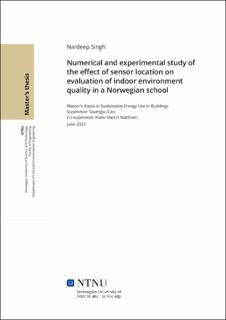| dc.contributor.advisor | Cao, Guangyu | |
| dc.contributor.advisor | Mathisen, Hans Martin | |
| dc.contributor.author | Singh, Nardeep | |
| dc.date.accessioned | 2024-01-12T18:19:52Z | |
| dc.date.available | 2024-01-12T18:19:52Z | |
| dc.date.issued | 2023 | |
| dc.identifier | no.ntnu:inspera:142431124:98327112 | |
| dc.identifier.uri | https://hdl.handle.net/11250/3111387 | |
| dc.description.abstract | Formålet med denne studien er å undersøke innemiljøet for Kuben videregående skole i Oslo kommune og er knyttet til det pågående DIGG-MIN-SKOLE prosjektet. Det er rapportert som en skole med kjente innemiljøproblemer. Denne studien evaluerer enkle tiltak for å forbedre miljøet med å forstå hvordan plassering av sensorer påvirker CO2-avlesningene.
Karbondioksidsensorer brukes som kontroll i høy energieffektiv ventilasjonsteknikk kjent som behovskontrollventilasjon. For å nøyaktig bestemme inneluftkvaliteten og reell tilluftsmengde mens du implementerer DCV, er måledatakvaliteten til CO2-sensorer avgjørende. I denne forskningen, blir numerisk fluiddynamikk brukt til å modellere og simulere luftstrømfeltet og CO2-rom distribusjon i et innendørs miljø i et klasserom med sittende CO2-genererende brukere. I denne oppgaven ble strømmninglinjene til klasserommets luftstrøm, vindhastighet, turbulens og fordeling av CO2 undersøkt. Å sikre nøyaktigheten av målingene og plassere CO2-sensorene i klasserommet riktig, er viktig for å sikre nøyaktige innsamling av måledata og for å få et effektiv DCV for å oppnå høy energieffektivitet.
Studien er utført gjennom feltmålinger og simuleringer. Kuben Videregående Skole hadde to forskjellige sensorer installert på skolen, Airthings View Plus-sensorer og ELMA Chauvin Arnoux. Disse to ble sammenlignet og evaluert i sammenheng med hverandre. Sensorene målte CO2, relativ fuktighet og temperaturnivåer i klasserom. Simuleringen ble deretter sammenlignet med disse resultatene. | |
| dc.description.abstract | The purpose of this study is to examine the indoor environment for Kuben High School in Oslo municipality and is connected with the ongoing DIGG-MIN-SKOLE project. It is reported as a school with known indoor environmental problems. The study is evaluating simple measures to improve the environment with understanding how the placement of sensors affect the CO2 readings.
Carbon dioxide sensors are used as the control input in the high energy efficiency ventilation technique known as demand control ventilation (DCV). In order to accurately determine the indoor air quality and real ventilation rate while implementing the DCV, the measurement data quality of CO2 sensors is crucial. In this research, computational fluid dynamics analysis was used to model and simulate the airflow field and CO2 spatial
distribution in an indoor environment of a classroom with seated CO2 generating occupants. The classroom’s airflow streamlines, velocity, turbulence, and spatial distribution of CO2 were examined. In order to ensure an accurate measurement data collection and achieve a high energy efficiency in the DCV system, we need to properly arrange the CO2 sensors.
The study have been conducted through field measurements and simulations. Kuben High School had two different sensors installed in the school, Airthings View Plus sensors and ELMA Chauvin Arnoux. These two were compared and evaluated in context of each other. The sensors measured CO2, relative humidity and temperature levels in the classroom. The simulation was then compared to these results. | |
| dc.language | eng | |
| dc.publisher | NTNU | |
| dc.title | Numerical and experimental study of the effect of sensor location on evaluation of indoor environment quality in a Norwegian school | |
| dc.type | Master thesis | |
